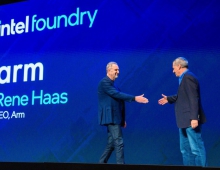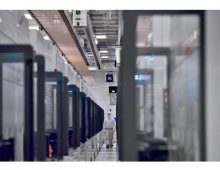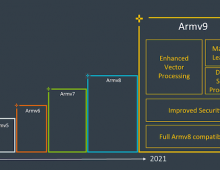
Next-generation Armv8.1-M Architecture Promises Enhanced Machine Learning and Signal Processing for Embedded Devices
Arm has announced the Arm Helium technology, the M-Profile Vector Extension (MVE) for the Arm Cortex-M series processors designed to enhance the compute performance of the Armv8.1-M architecture.
Arm says that the vector extension brings up to 15 times performance uplift to machine learning (ML) functions, and up to 5 times uplift to signal processing functions compared to existing Armv8-M implementations. It may be viewed as the Armv8-M architecture’s version of the Advanced SIMD Extension (Neon) in the A-Profile.
Advanced digital signal processing (DSP) is available today through Arm Neon technology in Cortex-A based devices. For more constrained applications, Arm also added DSP extensions in its higher performance Cortex-M processors (Cortex-M4, Cortex-M7, Cortex-M33 and Cortex-M35P). Both technologies can be used to accelerate ML compute in certain applications.
For the most constrained embedded systems where energy efficiency is prioritized, historically the solution has been coupling a Cortex processor with a DSP in SoCs, which adds complexity to both hardware and software design. As we look to incorporate more ML capabilities on to these devices, several existing SoC development challenges are intensified and require a higher level of expertise in utilizing different toolchains, programming, debugging and working with complex proprietary security solutions.
Armv8.1-M architecture new features
- A new vector instruction set extension (MVE)
- Additional instruction set enhancements for loops and branches (Low Overhead Branch Extension)
- Instructions providing half precision floating-point support
- Instruction improving state management of the Floating Point Unit (FPU)
- Enhancements to debug including:
- Performance Monitoring Unit (PMU)
- Unprivileged Debug Extension
- Debug support for MVE
- Reliability, Availability and Serviceability (RAS) extension
Arm says that the Armv8.1-M with Helium eliminates these challenges by delivering real-time control code, ML and DSP execution without compromising efficiency. In turn, millions of software developers will be able to securely scale intelligent applications that take advantage of DSP capabilities across a wider range of devices, enabling enhanced support for emerging applications across three key categories; vibration and motion, voice and sound, and vision and image processing. This could improve the user experience in future devices such as sensor hubs, wearables, audio devices and industrial applications powered by next-generation SoCs based on Cortex-M with Helium technology.
Software development will be made simpler due to Helium’s unified tool chain, libraries and models. The Helium toolchain includes the Arm Development Studio, encompassing Arm Keil MDK, Arm Models and various software libraries including CMSIS-DSP and CMSIS-NN, allowing developers to choose the best fit for their needs. And for signal processing applications Arm made it even simpler by removing the need for a dedicated DSP or function accelerator and eliminating another layer of design complexity.
Toolchain and models for Helium are available today and Arm expects Helium to be available in silicon within the next two years.





















